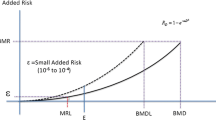Abstract
We present a Bayesian nonparametric modeling approach to inference and risk assessment for developmental toxicity studies. The primary objective of these studies is to determine the relationship between the level of exposure to a toxic chemical and the probability of a physiological or biochemical response. We consider a general data setting involving clustered categorical responses on the number of prenatal deaths, the number of live pups, and the number of live malformed pups from each laboratory animal, as well as continuous outcomes (e.g., body weight) on each of the live pups. We utilize mixture modeling to provide flexibility in the functional form of both the multivariate response distribution and the various dose–response curves of interest. The nonparametric model is built from a structured mixture kernel and a dose-dependent Dirichlet process prior for the mixing distribution. The modeling framework enables general inference for the implied dose–response relationships and for dose-dependent correlations between the different endpoints, features which provide practical advances relative to traditional parametric models for developmental toxicology. We use data from a toxicity experiment that investigated the toxic effects of an organic solvent (diethylene glycol dimethyl ether) to demonstrate the range of inferences obtained from the nonparametric mixture model, including comparison with a parametric hierarchical model.
Supplementary materials accompanying this paper appear on-line.






Similar content being viewed by others
References
Barrientos, A. F., Jara, A. & Quintana, F. A. (2012). On the support of MacEachern’s dependent Dirichlet processes and extensions. Bayesian Analysis 7, 277–310.
Calabrese, E. J. (2005). Paradigm lost, paradigm found: The re-emergence of hormesis as a fundamental dose response model in the toxicological sciences. Environmental Pollution 138, 378–411.
Catalano, P. & Ryan, L. (1992). Bivariate latent variable models for clustered discrete and continuous outcomes. Journal of the American Statistical Association 87, 651–658.
DeIorio, M., Johnson, W. O., Müller, P. & Rosner, G. L. (2009). Bayesian nonparametric non-proportional hazards survival modelling. Biometrics 63, 762–771.
DeIorio, M., Müller, P., Rosner, G. & MacEachern, S. (2004). An ANOVA model for dependent random measures. Journal of the American Statistical Association 99, 205–215.
DiLucca, M., Guglielmi, A., Müller, P. & Quintana, F. (2013). A simple class of Bayesian nonparametric autoregressive models. Bayesian Analysis 8, 63–88.
Dominici, F. & Parmigiani, G. (2001). Bayesian semiparametric analysis of developmental toxicology data. Biometrics 57, 150–157.
Dunson, D., Chen, Z. & Harry, J. (2003). A Bayesian approach for joint modeling of cluster size and subunit-specific outcomes. Biometrics 59, 521–530.
Faes, C., Geys, H., Aerts, M. & Molenberghs, G. (2006). A hierarchical modeling approach for risk assessment in developmental toxicity studies. Computational Statistics & Data Analysis 51, 1848–1861.
Fronczyk, K. & Kottas, A. (2014). A Bayesian nonparametric modeling framework for developmental toxicity studies (with discussion). Journal of the American Statistical Association 109, 873–893.
Gelfand, A. & Ghosh, S. (1998). Model choice: A minimum posterior predictive loss approach. Biometrika 85, 1–11.
Gelfand, A., Kottas, A. & MacEachern, S. (2005). Bayesian nonparametric spatial modeling with Dirichlet process mixing. Journal of the American Statistical Association 100, 1021–1035.
Gueorguieva, R. & Agresti, A. (2001). A correlated probit model for joint modeling of clustered binary and continuous responses. Journal of the American Statistical Association 96, 1102–1112.
Guindani, M. & Gelfand, A. E. (2006). Smoothness properties and gradient analysis under spatial Dirichlet process models. Methodology and Computing in Applied Probability 8, 159–189.
Hwang, B. S. & Pennell, M. L. (2013). Semiparametric Bayesian joint modeling of a binary and continuous outcome with applications in toxicological risk assessment. Statistics in Medicine 33, 1162–1175.
Kottas, A. & Fronczyk, K. (2013). Flexible Bayesian modelling for clustered categorical responses in developmental toxicology. In Bayesian Theory and Applications, Eds. P. Damien, P. Dellaportas, N. G. Polson & D. A. Stephens, pp. 70–83. Oxford University Press.
Kottas, A. & Krnjajić, M. (2009). Bayesian semiparametric modelling in quantile regression. Scandinavian Journal of Statistics 36, 297–319.
Kottas, A., Wang, Z. & Rodríguez, A. (2012). Spatial modeling for risk assessment of extreme values from environmental time series: A Bayesian nonparametric approach. Environmetrics 23, 649–662.
MacEachern, S. (2000). Dependent Dirichlet processes. Technical report, Ohio State University, Department of Statistics.
Nott, D. & Kuk, A. (2009). Analysis of clustered binary data with unequal cluster sizes: A semiparametric Bayesian approach. Journal of Agricultural, Biological, and Environmental Statistics 15, 101–118.
Price, C., Kimmel, C., George, J. & Marr, M. (1987). The developmental toxicity of diethylene glycol dimethyl ether in mice. Fundamentals of Applied Pharmacology 8, 115–126.
Regan, M. & Catalano, P. (1999). Likelihood models for clustered binary and continuous outcomes: application to developmental toxicology. Biometrics 55, 760–768.
Rodriguez, A. & ter Horst, E. (2008). Bayesian dynamic density estimation. Bayesian Analysis 3, 339–366.
Sethuraman, J. (1994). A constructive definition of Dirichlet priors. Statistica Sinica 4, 639–650.
Xiao, S., Kottas, A. & Sansó, B. (2015). Modeling for seasonal marked point processes: An analysis of evolving hurricane occurrences. The Annals of Applied Statistics 9, 353–382.
Acknowledgements
The work of the second author was supported in part by the National Science Foundation under award DMS 1310438. The authors wish to thank an Associate Editor and two reviewers for useful feedback and for comments that improved the presentation of the material in the paper.
Author information
Authors and Affiliations
Corresponding author
Electronic supplementary material
Below is the link to the electronic supplementary material.
Rights and permissions
About this article
Cite this article
Fronczyk, K., Kottas, A. Risk Assessment for Toxicity Experiments with Discrete and Continuous Outcomes: A Bayesian Nonparametric Approach. JABES 22, 585–601 (2017). https://doi.org/10.1007/s13253-017-0293-6
Received:
Accepted:
Published:
Issue Date:
DOI: https://doi.org/10.1007/s13253-017-0293-6




